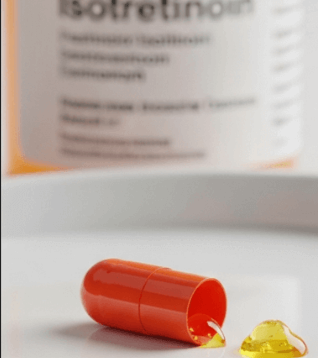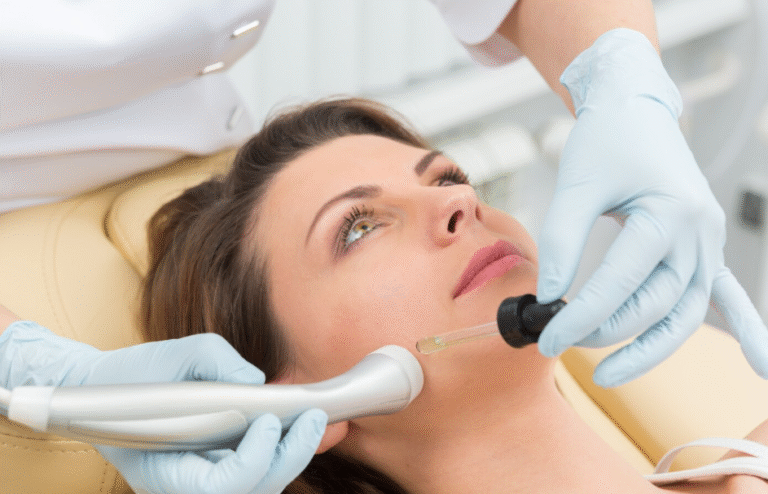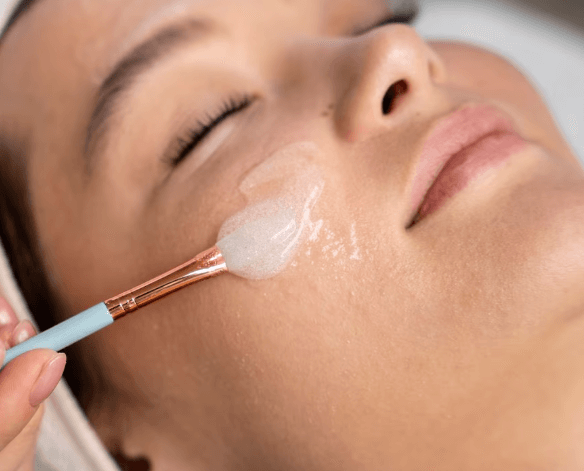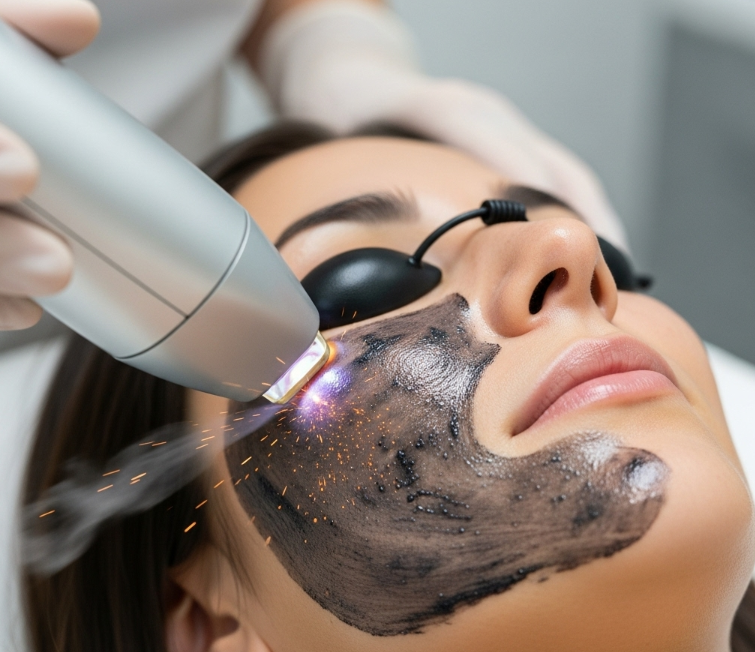Treatment Overview
Oral isotretinoin (commonly known by the brand name Accutane) is primarily used in Korea for severe acne, but it also plays a role in managing redness and flushing associated with rosacea and post-acne erythema. Isotretinoin works by reducing sebaceous gland activity, lowering inflammation, and remodeling the skin barrier, which indirectly helps stabilize vascular reactivity and reduce chronic redness.
Korean dermatologists prescribe isotretinoin carefully and in low-dose regimens for patients with persistent redness and acne overlap, as well as in resistant cases of rosacea. It is rarely used as a first-line treatment for redness alone but can be an effective option for patients who fail to respond to lasers, antibiotics, or topicals.
For redness and flushing, Oral Isotretinoin Therapy:
- Reduces oil production, preventing inflammatory flare-ups.
- Decreases vascular sensitivity in rosacea.
- Improves post-acne erythema through long-term dermal remodeling.
- Provides durable results when carefully monitored.
Purpose & Benefits
- Sebum Regulation: Reduces oiliness that worsens redness and flushing.
- Anti-Inflammatory Effect: Calms vascular and skin inflammation.
- Redness Reduction: Improves rosacea-related erythema.
- Barrier Remodeling: Strengthens skin structure, reducing long-term reactivity.
- Combination-Friendly: Works well alongside lasers and topical redness creams.
Ideal Candidates
Oral Isotretinoin Therapy in Korea is recommended for:
- Patients with rosacea + acne overlap.
- Individuals with persistent post-acne redness unresponsive to peels or lasers.
- Adults with oil-triggered flushing episodes.
- Patients who failed antibiotics or topical redness therapies.
- Those seeking long-term improvement in both redness and acne-prone skin.
Comparison with Other Treatments
- Oral Isotretinoin: Strong systemic option for acne + redness overlap; long-term dermal remodeling.
- Antibiotics (Doxycycline, Minocycline): Anti-inflammatory, faster action in rosacea; fewer long-term changes.
- Beta-Blockers (Propranolol, Carvedilol): Reduce adrenaline-driven flushing; no acne benefit.
- Anti-Redness Lasers (PDL, V-Beam, Nd:YAG): Target vessels directly; stronger effect for vascular redness.
- Erythema-Reducing Creams: Topical daily redness control; no systemic impact.
- Moisture Therapy: Strengthens barrier but does not address oil-driven triggers.
Possible Risks & Complications
Isotretinoin is highly effective but requires close monitoring. Risks include:
- Dry skin, lips, and eyes (very common).
- Photosensitivity and easier flushing with UV exposure.
- Liver enzyme elevation and altered lipid levels (bloodwork required).
- Mood changes or headaches in rare cases.
- Teratogenicity (strict pregnancy prevention required).
Treatment Techniques Used
- Low-Dose Regimens: Korean dermatologists often prescribe micro-dosing (5–20 mg daily) for redness and rosacea overlap.
- Duration: 3–6 months typical; longer for resistant cases.
- Combination Therapy: Often combined with lasers, cooling masks, and topical barrier creams.
- Monitoring: Regular blood tests for liver function and lipids.
- Clinic Integration: Moisture therapy and herbal soothers added to reduce dryness and irritation.
Recovery & Aftercare
- First 2–4 Weeks: Initial dryness, flushing may temporarily worsen.
- 1–2 Months: Oil control improves; redness begins to settle.
- 3–6 Months: Long-term reduction in post-acne erythema and vascular sensitivity.
Aftercare Tips:
- Apply lip balm and moisturizer frequently to manage dryness.
- Use SPF 50+ daily to protect from UV-triggered redness.
- Avoid alcohol and unnecessary medications affecting the liver.
- Do not combine with high-dose vitamin A supplements.
- Female patients must follow strict pregnancy prevention protocols.
Results & Longevity
- Short-Term (1–2 Months): Reduced oiliness and inflammatory redness.
- Medium-Term (3–6 Months): Clearer skin with fewer flare-ups and less post-acne erythema.
- Long-Term: Remission may last years; sometimes requires maintenance micro-dosing.
Treatment Process in Korea
- Consultation & Screening – Dermatologist checks redness severity, acne overlap, and blood tests.
- Prescription – Low-dose isotretinoin tailored to patient’s condition.
- Usage Instruction – Education on dryness management, sunscreen, and dietary precautions.
- Clinic Add-Ons – Moisture therapy, cooling masks, and herbal calming used to balance dryness.
- Follow-Up – Regular lab monitoring and dosage adjustments for safety.
Why Korea is a Top Destination
- Korean dermatologists specialize in low-dose isotretinoin regimens for redness + acne overlap.
- Integration of moisture therapy, herbal infusions, and cooling masks to reduce side effects.
- Affordable compared to Western isotretinoin programs.
- Emphasis on precision tailoring rather than one-size-fits-all dosing.
- Korea is a global leader in combining systemic therapy with barrier-focused aftercare.
Cost Range (Detailed Breakdown)
Pricing for Oral Isotretinoin Therapy in Korea for redness & flushing:
- Consultation Fee: USD 20 – 50.
- Prescription Isotretinoin (1-Month Supply): USD 30 – 70.
- Blood Tests (Liver, Lipid Monitoring): USD 30 – 80 per visit.
- Clinic Add-Ons (Moisture therapy, cooling masks, herbal infusions): USD 50 – 150.
- Premium Rosacea/Redness Program (Isotretinoin + Lasers + Aftercare): USD 800 – 2,000 (3–6 months).
Additional Costs in Korea:
- Medical-grade moisturizers and lip balms: USD 20 – 50.
- Sunscreens for isotretinoin patients: USD 20 – 40.
💡 Patients often call isotretinoin the “reset pill”, since it not only clears acne but also reduces redness triggers when carefully dosed.
Popular Clinics in Seoul
- Oracle Dermatology – Low-dose isotretinoin + redness control laser programs.
- Banobagi Dermatology – Acne + redness overlap management with isotretinoin and hydration therapy.
- Renewme Skin Clinic – Isotretinoin combined with herbal soothers and cooling aftercare.
- View Plastic & Dermatology – Multi-step programs: isotretinoin, lasers, and barrier repair.
- Chaum Anti-Aging Center – Premium rosacea + acne programs integrating isotretinoin with regenerative infusions.




